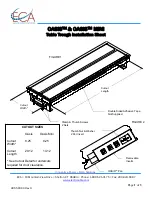
7
Packaging
When developing mountings and enclosures for S ¯olarc
lamps and ballasts there are several design aspects
to consider.
Heat management is critical. In many applications
forced-air cooling is used to maintain the recommended
temperatures at the critical measurement points. For
S ¯olarc lamps with no cover glass, drawing the air across
the face of the lamp is preferable—blowing air on the
lamp is not recommended. Use the natural effect of heat
rising as a supplement to drawing the air up from the
bottom of the lamp. This is how all devices manufactured
by Welch Allyn are designed. If the system cannot be
cooled using forced-air cooling, such as in a flashlight or
torch, sufficient thermal conduction methods must be used
to assure critical thermal points are within specification.
When designing light engine and light module components
which incorporate vents and cooling fans, be careful to
assure sufficient clearance and pathways so that the airflow
is not obstructed.
While S ¯olarc lamps have no filament to break, they are
nonetheless made of quartz glass and subject to breakage
from shock and vibration. Shock mounting techniques and
shock isolation can provide a more robust design.
Remember it is up to you, the OEM, to test the end
product in its intended use to assure it meets your
customer’s requirement.
Mounting
S ¯olarc arc lamps are specified for operation in a specific
orientation, such as horizontal or vertical base down.
Verify specified orientation with the appropriate lamp
specification sheet. Lamps specified for horizontal
operation have a preferred rotational orientation. Refer to
the specific lamp data sheet or follow the “THIS SIDE UP”
or “UP” designation on the lamp base. To prevent damage
during lamp installation, mounting and replacing, care
must be taken to avoid mechanical interference with the
quartz arc tube.
Mount the printed circuit board version of the ballast as
desired by using the four corner through-holes provided
on the circuit board assembly or by some other acceptable
means. Exercise care when handling and mounting the
circuit board assembly to prevent mechanical stressing of
the ballast components. It is not recommended to use the
ballast heat sink for mounting, as it is electrically floating.
Since there is high voltage on the board, spacing of
9.53 mm (0.375 in) on all sides of the ballast is required,
or appropriate nonconductive electrical insulating
material must be used.
Electromagnetic Interference (EMI)
The S ¯olarc product family has been designed to pass
industry-standard EMI requirements. The ballast should be
located close to the lamp for this very reason. It may be
necessary to add an additional metal shield over both the
lamp and ballast depending on the specified EMI immunity
levels. In addition, it is best to keep the distance from the
power source to the ballast as short as possible. When
specifying long wire lengths it is best to use twisted pair
configuration and/or shielded wire to minimize radiated
EMI from that wire.
System Integration Guidelines to Minimize EMI
Ballasts and other power conversion circuitry emit parasitic
energy that may affect or interfere with the operation of
other equipment. The following guidelines are recommended
to minimize ballast emissions and reduce the possibility of
radiated or conducted interference with other equipment.
• Overlapping sections of the ballast/electronic enclosure should
be clean and free from paint
• Use metal screws to fasten cabinet sections together
• Attempt to keep fasteners approximately two inches apart
and avoid any distortion of the clean metal mating surfaces.
Use EMI gasketing if distortion is unavoidable
• Avoid dissimilar shielding metals and moisture that will cause
galvanic action and thus cause deterioration of the clean
metal shielding surfaces
• Maximum shielding occurs with materials that have the
highest conductivity
• Principal EMI issues arise due to breaches in shielding
• Cover or subdivide areas inside large electronic enclosures
• Avoid long ground wire connections to reduce loop size
• Route all internal cables as close to the ground plane/surfaces
as possible to minimize loop size
• Use an IEC power input filter module
• Mount an IEC power input filter module to a clean, paint-free
section of the cabinet wall and as close as possible to the DC
power supply. Use the widest and shortest possible strap to
ground the input filter module to the ground plane if unable to
ground the filter module directly to cabinet wall
• Plastic-coated enclosures provide excellent HF shielding but
considerable care is needed to ensure that all seams are
conductively closed
• Do not route cables close to seams or openings and especially
not close to small openings or cracks
• Terminate all cable shields to the enclosure
DESIGNING S¯olarc LAMPS INTO
YOUR PRODUCTS



































